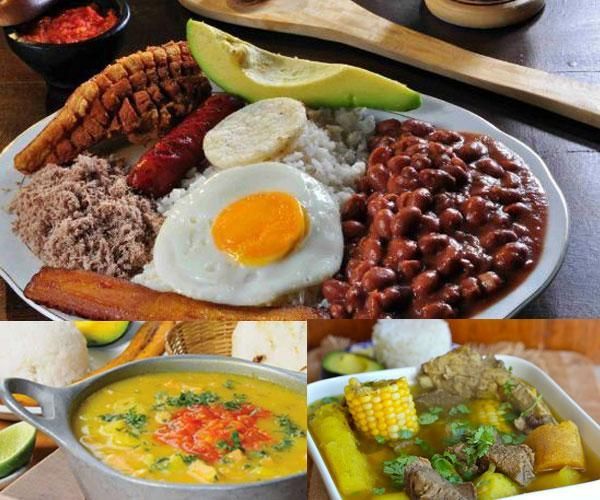
Unsplash

Miércoles, 12 de febrero, 2025.
Cuando visitas el departamento de Antioquia en Colombia te enamoras de muchas cosas, entre ellas, de su gastronomía, con una de las preparaciones culinarias más representativas: la bandeja paisa.
La bandeja paisa no es solo un plato típico; es un testimonio de historia, resistencia y mestizaje. Su origen no tiene un único punto de partida, sino que se teje entre la tradición indígena, la influencia española y la necesidad de los campesinos antioqueños de crear una comida sustanciosa para enfrentar largas jornadas de trabajo. No nació con un nombre ni con una receta estricta. Se fue moldeando con el tiempo, sumando ingredientes que estaban al alcance de quienes la preparaban.

Tenor
Los indígenas de la región ya consumían maíz, frijoles y tubérculos mucho antes de la llegada de los conquistadores. Con la colonización española llegaron las carnes de cerdo y res, además del arroz, que con el tiempo se convirtió en un acompañante infaltable. La necesidad de alimentarse bien con lo que había disponible llevó a la combinación de estos elementos en un solo plato, pensado para dar energía y saciedad. Era un reflejo de la vida rural: generoso, abundante, sin pretensiones.
Aunque su fama como “bandeja paisa” surgió en el siglo XX, su esencia venía de siglos atrás. En los años setenta y ochenta, con el auge del turismo y la búsqueda de una identidad gastronómica propia, el plato se consolidó con los ingredientes que hoy lo caracterizan: arroz, frijoles, carne molida, chicharrón, huevo frito, plátano maduro, morcilla, chorizo, aguacate y arepa. No hay reglas estrictas sobre su preparación, pero la esencia sigue siendo la misma: abundancia, tradición y sabor.

Tenor
Más que un plato, es un símbolo. Es la nostalgia de los paisas por su tierra cuando están lejos, el orgullo de los restaurantes que la sirven como emblema de identidad, el reflejo de una cultura que valora la comida como un acto de generosidad. Cada bocado cuenta una historia de migraciones, adaptaciones y costumbres transmitidas de generación en generación. La bandeja paisa no es solo comida, es historia servida en un plato.
Recuerdo mi primer viaje a Medellín, la capital de Antioquia cuando tenía trece años... Viajábamos por carretera, mi mamá y yo, atravesando montañas que parecían infinitas. El verde lo cubría todo, y el aire tenía ese olor a tierra mojada que solo se siente en los pueblos después de la lluvia. Paramos en un restaurante al borde del camino, de esos con sillas de madera y paredes de tapia blanca, donde el sonido de la cocina se mezcla con el murmullo de los comensales. Mi mamá dijo que teníamos que probar la bandeja paisa, que no había manera de estar en Antioquia y no comerla como se debe, servida en un plato grande, casi desbordado, con cada ingrediente acomodado como si tuviera su propio espacio.
Cuando la trajeron, me sorprendió el tamaño. Era una montaña de comida que parecía imposible de terminar, pero más que la cantidad, me impresionó la mezcla de colores y texturas. El arroz blanco contrastando con los frijoles oscuros, el chicharrón crujiente junto al huevo con su yema dorada, el plátano maduro brillando con ese tono caramelizado, el aguacate fresco, la arepa sencilla pero imprescindible. Probé primero los frijoles, espesos y con ese sabor ahumado que solo se consigue con paciencia. Luego el chicharrón, crocante por fuera y tierno por dentro. El arroz se mezclaba con la carne molida, el huevo chorreaba sobre todo, y el dulce del plátano equilibraba cada bocado. Era una explosión de sabores, pero no de esas que abruman, sino de las que reconfortan.

Tenor
Comerla fue más que probar un plato típico, fue una experiencia. Mi mamá, con esa nostalgia de quien ya conocía el sabor de antes, me miraba sonriendo entre bocados, como si quisiera asegurarse de que entendiera lo que significaba. Era más que comida, era tradición, historia, identidad. No terminé todo, porque la bandeja paisa no se come, se enfrenta, y yo, en mi primer intento, perdí la batalla, pero me fui con la certeza de que en cada plato así servido había un pedazo de Colombia, de su gente, de su pasado y su presente, y con la promesa de que algún día regresaría para intentarlo de nuevo, de hecho, las veces que he tenido la oportunidad de viajar a Medellín todavía sigo visitando un rincón del país en donde puedo probar la bandeja paisa, claro, en una presentación más pequeña para poder comer todo porque no es correcto desperdiciar la comida, sea de un restaurante o en casa.
Creo que viajar sin probar la comida local es como ver una película sin sonido, como leer un libro sin pasar de la primera página. Cada plato cuenta algo, incluso antes del primer bocado. Los ingredientes hablan de lo que la tierra da, las especias de las influencias que han pasado por ahí, las preparaciones de la paciencia o la prisa de quienes cocinan. Aprender a comer lo que otros consideran cotidiano es también una forma de entender su historia sin necesidad de palabras.
Al principio cuesta, porque el paladar está acostumbrado a lo que conoce, a lo que reconforta. Pero abrirse a nuevos sabores es abrirse a nuevas formas de ver el mundo. La primera vez que probé una sopa con ingredientes que jamás habría combinado, dudé. Pero luego entendí que esa mezcla no era casualidad, era el resultado de siglos de ensayo y error, de generaciones perfeccionando lo que para ellos es un símbolo de hogar. Lo mismo con un pescado crudo servido con arroz avinagrado, con un postre que no es dulce sino salado, con un café que se toma frío en lugar de caliente. Cada cucharada, un aprendizaje.
Lo más interesante es que muchas veces los platos viajan más que las personas. Una receta puede haber cruzado continentes, haber cambiado de nombre y de ingredientes, haber sido adaptada a distintos gustos sin perder su esencia. Comer en otro país, en otra ciudad, en otro pueblo, es encontrar rastros de esas historias, reconocer similitudes en lo que parecía ajeno.
No siempre es fácil. A veces un sabor es demasiado fuerte, una textura demasiado extraña, una preparación demasiado diferente a lo que uno espera. Pero eso también es parte del viaje. No se trata de que todo guste, sino de permitirse descubrir, de respetar lo que otros consideran un manjar, de entender que la identidad de un lugar también se sirve en un plato. Porque al final, la comida no es solo alimento, es memoria, es cultura, es la forma más sencilla y sincera en la que un territorio dice: esto es lo que somos.

Fuente
Esta fue una publicación de miércoles.
Gracias por pasarse a leer un rato, amigas, amigos, amigues de Blurt.
Que tengan un excelente día y que Dios los bendiga grandemente.
Saludines, camaradas blurtinenses!!

Wednesday, february 12th, 2025.
When you visit the department of Antioquia in Colombia you fall in love with many things, including its gastronomy, with one of the most representative culinary preparations: the bandeja paisa.
The bandeja paisa is not just a typical dish; it is a testimony of history, resistance and fusion. Its origin does not have a single starting point, but is woven between indigenous tradition, Spanish influence and the need of Antioquian peasants to create a substantial meal to face long work days. It was not born with a name or a strict recipe. It was shaped over time, adding ingredients that were within reach of those who prepared it.

Tenor
The indigenous people of the region were already eating corn, beans and tubers long before the arrival of the conquistadors. With the Spanish colonization came pork and beef, as well as rice, which over time became an essential accompaniment. The need to eat well with what was available led to the combination of these elements in a single dish, designed to provide energy and satiety. It was a reflection of rural life: generous, abundant, unpretentious.
Although its fame as “bandeja paisa” arose in the 20th century, its essence came from centuries before. In the seventies and eighties, with the rise of tourism and the search for its own gastronomic identity, the dish was consolidated with the ingredients that characterize it today: rice, beans, ground beef, pork rind, fried egg, ripe plantain, blood sausage, chorizo, avocado and arepa. There are no strict rules about its preparation, but the essence remains the same: abundance, tradition and flavor.

Tenor
More than a dish, it is a symbol. It is the nostalgia of the paisas for their land when they are far away, the pride of the restaurants that serve it as an emblem of identity, the reflection of a culture that values food as an act of generosity. Each bite tells a story of migrations, adaptations and customs passed down from generation to generation. The bandeja paisa is not just food, it is history served on a plate.
I remember my first trip to Medellín, the capital of Antioquia when I was thirteen years old... We were traveling by road, my mother and I, crossing mountains that seemed endless. Green covered everything, and the air had that smell of wet earth that you only feel in towns after the rain. We stopped at a restaurant on the side of the road, one of those with wooden chairs and whitewashed walls, where the sound of the kitchen mixes with the murmur of the diners. My mom said we had to try the bandeja paisa, that there was no way to be in Antioquia and not eat it properly, served on a large, almost overflowing plate, with each ingredient arranged as if it had its own space.
When they brought it, I was surprised by the size. It was a mountain of food that seemed impossible to finish, but more than the quantity, I was impressed by the mix of colors and textures. The white rice contrasting with the dark beans, the crispy pork rind next to the egg with its golden yolk, the ripe plantain shining with that caramelized tone, the fresh avocado, the simple but essential arepa. I tried the beans first, thick and with that smoky flavor that can only be achieved with patience. Then the pork rind, crispy on the outside and tender on the inside. The rice mixed with the ground beef, the egg dripped over everything, and the sweetness of the plantain balanced each bite. It was an explosion of flavors, but not the kind that overwhelms, but the kind that comforts.

Tenor
Eating it was more than just trying a typical dish, it was an experience. My mother, with the nostalgia of someone who already knew the flavor before, looked at me smiling between bites, as if she wanted to make sure I understood what it meant. It was more than food, it was tradition, history, identity. I didn't finish it all, because the bandeja paisa is not eaten, it is fought, and I, in my first attempt, lost the battle, but I left with the certainty that in each dish served like that there was a piece of Colombia, of its people, of its past and its present, and with the promise that one day I would return to try it again. In fact, the times I have had the opportunity to travel to Medellín I still continue to visit a corner of the country where I can try the bandeja paisa, of course, in a smaller presentation so I can eat everything because it is not right to waste food, whether from a restaurant or at home.
I think that traveling without trying local food is like watching a movie without sound, like reading a book without getting past the first page. Each dish tells something, even before the first bite. The ingredients speak of what the earth gives, the spices of the influences that have passed through there, the preparations of the patience or the haste of those who cook. Learning to eat what others consider everyday is also a way of understanding its history without the need for words.
At first it is difficult, because the palate is accustomed to what it knows, to what comforts. But opening up to new flavors is opening up to new ways of seeing the world. The first time I tried a soup with ingredients that I would never have combined, I hesitated. But then I understood that this mixture was not a coincidence, it was the result of centuries of trial and error, of generations perfecting what for them is a symbol of home. The same with a raw fish served with vinegared rice, with a dessert that is not sweet but salty, with a coffee that is drunk cold instead of hot. Each spoonful, a learning experience.
The most interesting thing is that many times dishes travel more than people. A recipe may have crossed continents, changed its name and ingredients, been adapted to different tastes without losing its essence. Eating in another country, in another city, in another town, is finding traces of those stories, recognizing similarities in what seemed alien.
It is not always easy. Sometimes a flavor is too strong, a texture too strange, a preparation too different from what one expected. But that is also part of the journey. It is not about liking everything, but about allowing oneself to discover, to respect what others consider a delicacy, to understand that the identity of a place is also served on a plate. Because in the end, food is not just nourishment, it is memory, it is culture, it is the simplest and most sincere way in which a territory says: this is who we are.

Source
This was a wednesday post.
Thanks for stopping by to read for a while, Blurt friends.
Have a great day and may God bless you greatly.
Regards, comrades blurtarians!!
Translation: Deepl.com
